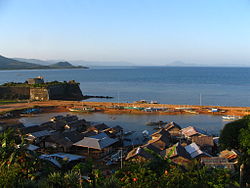Taytay, Palawan
| Taytay | ||
|---|---|---|
| Municipality | ||
 |
||
|
||
 Map of Palawan with Taytay highlighted |
||
| Location within the Philippines | ||
| Coordinates: 10°49′N 119°31′E / 10.817°N 119.517°ECoordinates: 10°49′N 119°31′E / 10.817°N 119.517°E | ||
| Country | Philippines | |
| Region | MIMAROPA (Region IV-B) | |
| Province | Palawan | |
| Congr. district | 1st district | |
| Founded | 1623 | |
| Barangays | 31 | |
| Government | ||
| • Mayor | Romy L. Salvame | |
| Area | ||
| • Total | 1,257.68 km2 (485.59 sq mi) | |
| Population (2010) | ||
| • Total | 70,837 | |
| • Density | 56/km2 (150/sq mi) | |
| Time zone | PST (UTC+8) | |
| Zip Code | 5312 | |
| Dialing code | 48 | |
Taytay is a first class municipality in the province of Palawan, an island of the Philippines.
According to the 2010 census, it has a population of 70,837 people.
Since 2002, its Cathedral of St. Joseph the Worker is the episcopal see of the pre-diocesan missionary Apostolic Vicariate of Taytay.
Before the Spanish colonization, The Kingdom of Taytay was ruled by a monarch noted as followed everywhere at any given time by ten scribes. The crew of Ferdinand Magellan held the Taytay king and queen for ransom after escaping the Battle of Mactan where Magellan was slain. They intended to secure more supplies as they plan to cross into the Moluccas where the Portuguese were so help can be sought. The native king and his subjects complied with the demands and even added more food supplies than what they asked for. This was duly recorded by Antonio Pigafetta, Magellan's chronicler, who was on board in one of the ships when these events took place.
Pigafetta also took note of one curious thing in the kingdom. He found the natives fond of cockfighting, long before this pastime was seen or even heard of in the Western Hemisphere.
During the Spanish colonization of the Philippines, Taytay was formally founded in 1623. Taytay became the capital of the province of Calamianes, the entire territory of Paragua (now Palawan), in 1818; and the province of Castilla, a land area occupying the northern part of Palawan, in 1858.
Archived baptismal records of Cuyo, Palawan show that the last monarch of the Kingdom of Taytay was converted to Christianity and christened Flores de los Santos Cabaylo meaning Cabaylo, Flower of the Saints. No other sovereign royal datu after him ruled in his kingdom. King Cabaylo's descendants include the present clans of Cabaylo-Manlavi-Gabinete-Macolor as main genealogical roots. His Royal Highness Datu Dr. Fernando Macolor Cruz who hailed from the Cabailo-Manlavi-Gabinete-Macolor line of the royal house is the present pretender and sole claimant to the most serene and ancient throne of the Kingdom of Taytay.
...
Wikipedia


